Despite the clear science on shale gas infrastructure and its dire impact on the climate, despite mounting opposition from local townships, despite a series of high-profile leaks from pipeline failures, the expansion of shale gas infrastructure continues at an unprecedented rate[1]. The Energy Policy Act of 2005[2] stripped the Environmental Protection Agency’s ability to regulate the drilling process of fracking, coinciding with the ‘fracking boom’ itself. A variety of health impacts including poisoned drinking water wells are reminders that fracking is not risk or cost free. At the time, hydraulic fracturing was being sold to the American public as the solution for ‘energy independence’ and promoted as a ‘bridge fuel‘ that would connect the country to a distant future of maybe-renewables. Thirteen years later, there is no significant energy transition, even while many countries have embraced renewable technology, if not fully in fact, certainly in spirit. Local communities are left in a vacuum of policy direction, fighting the rollout of fracking infrastructure with few tools available.
In the absence of clear alternatives, what are strategies local communities can utilize to stop or mitigate default extraction industries from building out new projects with the knowledge that the current Trump administration is pushing to limit input from the public for new pipeline developments?
In the two years that Visualizing Pipeline Impacts (VzPI) has worked with grass-roots communities in Orange & Sullivan Counties of New York (Protect Orange County, Sullivan County Residents Against Millennium (SCRAM), Delaware Riverkeeper Network and Concerned Citizens for Hudson Valley) we’ve developed, participated in and witnessed many strategies that have effectively accomplished three goals:
- Document public opposition within the legal systems that permit projects;
- Increase community awareness and public feedback to state agencies by visualizing real-world impacts;
- Disrupt the normal course of business through civil disobedience.
As a strategic roadmap, these methods range from engagement with formalized bureaucracies (a low risk / high detail engagement) to strategic use of nonviolent protest with high-value social media (a high risk / high detail engagement).
Legal Intervening – FERC
The most common starting point for any community, after holding a community meeting and gathering a list-serve is to register as an intervenor on a given project docket with the Federal Regulatory Energy Commission Website. This allows residents to become legal intervenors in a pipeline development and be kept abreast of the project’s timeline, documentation, permitting and community commenting as it moves forward in the process. From a data point of view, this can also present a narrative snapshot of how mobilized the community is in opposition to given project and where this opposition resides. An example of this is the practicum that Stephen Metts did with several Milano students in 2016 to map intervenors in the Northeast Region of the US.
When the compressor station in Highland NY was first announced, we worked with SCRAM to share and organize all the media from the buffet-style “informational event” Millennium Pipeline staged. Instead of a coherent informational presentation where questions could be fielded collectively, residents where shuttled from one company spokesperson to another. This proved helpful in assessing specific promises or claims being made by the company, which could then be cited as documented misinformation in the FERC commenting process.
In order to facilitate greater community participation, we developed a visual FERC instruction and commenting guide for the local public during this process. While many of the comments are emotionally-charged, residents were advised to cite specific, local knowledge, especially around a known impact. These more empirical comments weigh much more heavily in a legal process than someone’s opinion regarding a given project.
Public Testimony – Legal Hearings DEC
On the State level, the New York State Department of Environmental Conservation (NYSDEC) holds hearings with the local community to assess local impacts from the community that best knows the area and how it will be impacted. These more formal public hearings are also part of the legal record for each project docket online, and thus are a critical component for community mobilization. For Visualizing Pipeline Impacts, there were several visual and textual arguments we built from data and media that was submitted both in the FERC commenting process for the Eastern System Upgrade (ESU) and Valley Lateral Connect (VLC) projects. These were also physically presented during the NYSDEC hearings that were held in Sullivan and Orange County in the summer of 2017.
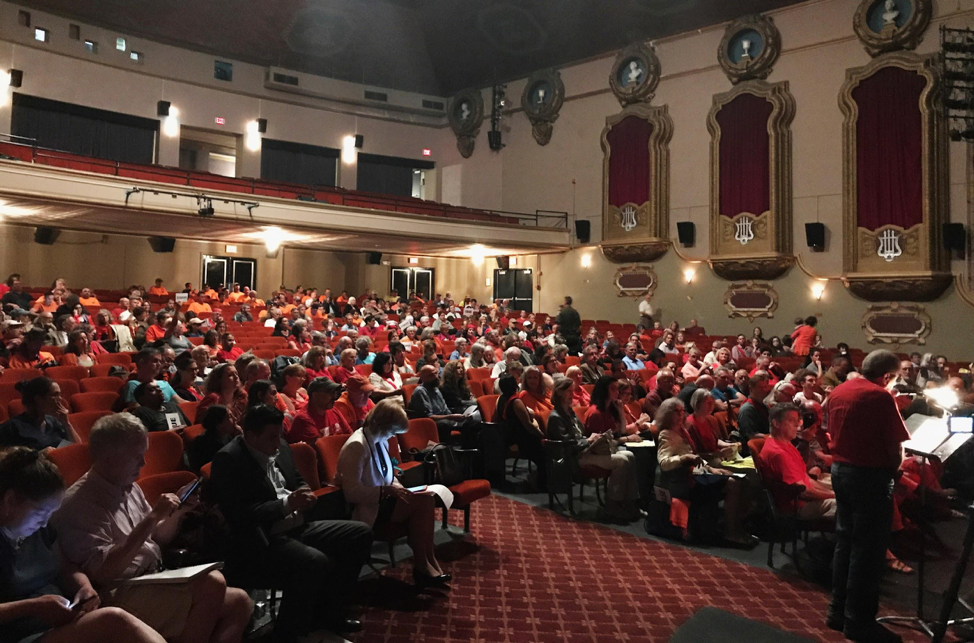
Remote sensing imagery was used to analyze Orange County farmer James Bastek’s land where a pipeline was installed, significantly decreasing crop yields. The combination of Stephen Metts’s quantitative analysis of the farmland, with the public testimony of this farmer was powerful. Bastek received the only standing ovation that evening in three hours of timed, three minute testimonials. Jess Irish spoke to the water impacts of the VLC pipeline as it would cross 23 significant wetlands and use a process known as HDD, which has experienced three high-profile failures in the Marcellus Shale region in 2017-18 alone. Lastly, Metts developed an environmental justice map from census data used to permit the CPV power plant, which was presented by Patricia McMillan.
Visualizing Impacts – On the Ground
While the visual analysis of wetland maps or environmental justice tracts have been impactful in presenting legal arguments to state agencies, documenting on-the-ground impacts through social media has been the most successful use of media. Activists like Pramilla Malick from Protect Orange County, have used Facebook as primary platforms to document the impacts of the CPV power plant, schedule weekly protest rallies and hold regular press events following legal hearings. Malick has used social media both to update the community on the status of the plant, as well as document community health impacts from early diesel tests and publish live town hall petitions within the Orange County Legislature as the permitting for this plant has now been implicated by the guilty verdict in the Percoco trial.
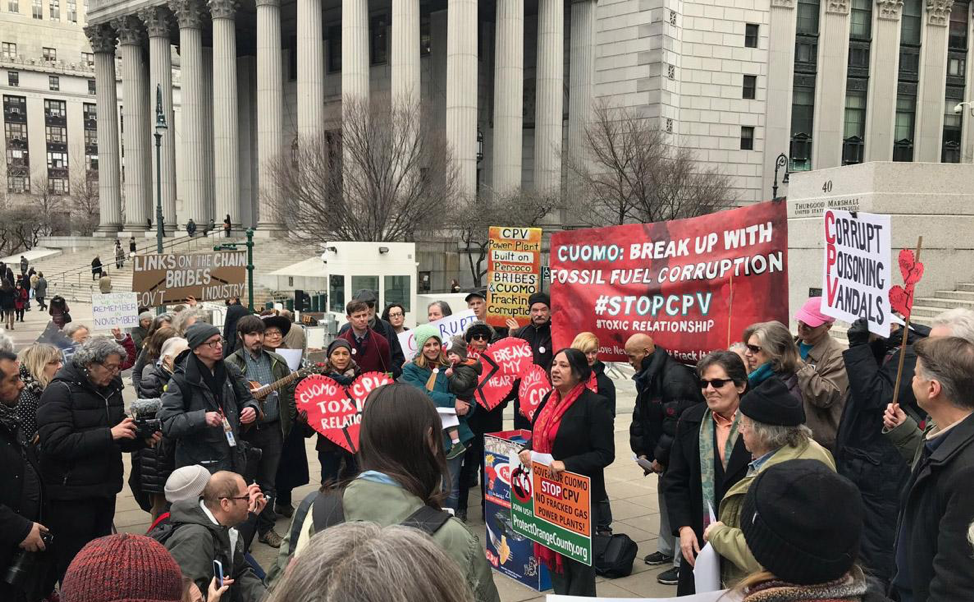
Other resident activists have used Facebook Live “check in” on the pipeline development on a regular basis, often drawing a viewing audience in the thousands. Millennium Pipeline company responded by filing a SLAPP suit against one resident, which was later tossed out by the presiding judge. The simple actions of bearing witness to pipeline development are not without risk; oil and gas lawsuits to silence and intimidate the public are on the rise across the US, even when they are in clear violation of the first amendment.
While social media can easily devolve into “preaching to the choir,” posts that garner attention from a broader audience, such as this disgruntled post about the compressor station in the Town of Highland, NY not only gained over 10,000 views, but the comment thread became an opportunity to share difficult-to-access documents, such as Millennium Pipeline’s projected annual hazardous air pollutants (HAPS) or statistics showing increased production of natural gas is not necessarily linked to increased domestic need as much as offshore LNG exports. Whether or not providing factual, scientific data in a ‘post-truth’ era will change minds remains to be seen, but sharing specific information around health and environmental impacts of natural gas infrastructure has been effective in debunking the pro-gas myths that claim only economic gains with no public risks.
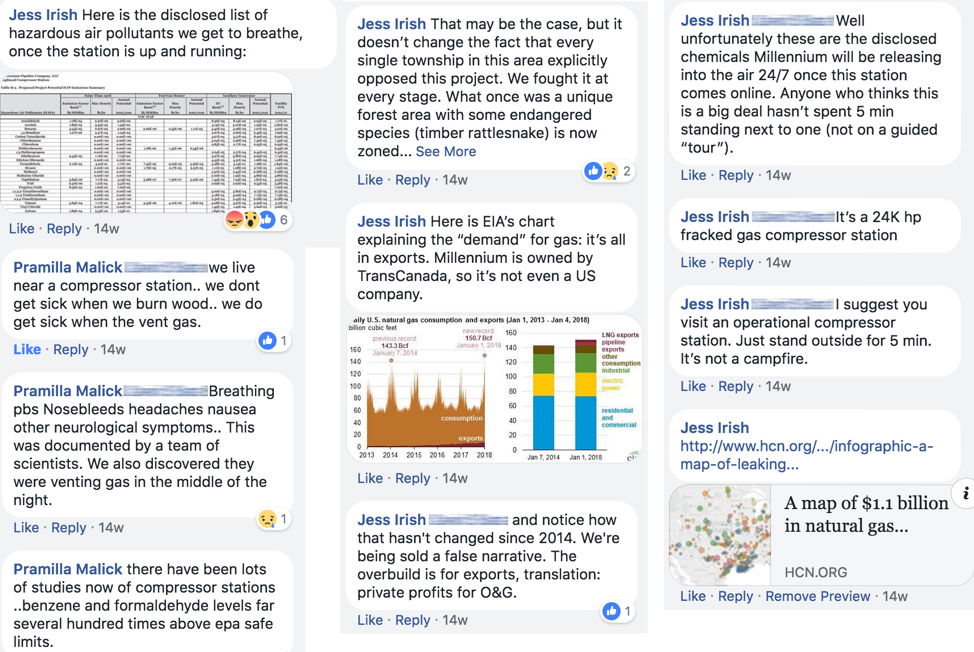
Visualizing Impacts – From the Air
As part of the Visualizing Pipeline Impacts project, imaging via several drone shootings compliments on-the-ground footage of forest destruction for the VLC pipeline and Town of Highland, NY compressor station. One of the main challenges in accessing any pipeline-related project is ensuring one has permitted right-of-access and that weather and safety protocols are followed, ensuring no one is put at risk. In spite of the limiting factors, remote imaging coupled with on-the-ground footage provides a community with much needed monitoring project activity.
Some questions we have asked upon examining the resulting drone footage: did the environmental impact statement include any language about the erosion impacts of this steep incline that feeds directly into a watershed area? Did the pipeline company gain permission from the land owners prior to tree felling on properties still requiring eminent domain proceedings? Is the sensitive watershed area within the construction site being properly protected during construction? Did blasting occur during clearing phases of the project, and if so, were permits secured? Will blasting activities impact known timber rattlesnake habitat and dens in the area – a protected, endangered species in NYS?
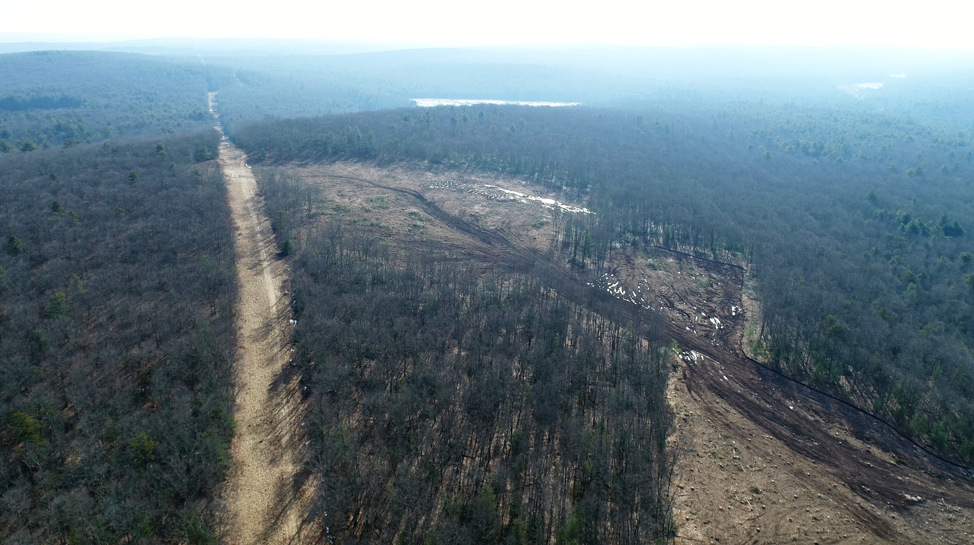
Requesting Transparency – FOIL and FOIA
Because Federal environmental regulation over oil and gas drilling has been curtained since 2005, it is left largely to State agencies to enact tougher environmental review both on drilling practices and pipeline infrastructure. Local communities have been effective in pressuring State agencies, including the NYSDEC and US Fish and Wildlife Service (USFWS). In the case of VLC – the pipeline necessary to feed the CPV Power Plant in Orange County, New York – actively campaigning for the denial of the project’s 401 water quality permit. Eventually the 401 water quality permit was indeed denied by NYSDEC, only to be over-ruled by the FERC, resulting in immediate construction. This sparked on-the-ground protests, call-ins as well as further analysis of a previously filed FOIA request for documents related to the USFWS concurrence of the project.
FOIL, or “Freedom of Information Law,” is a state mandate that allows the public access-by-request to records held and produced by state governmental agencies, including the legislature. FOIA stands for “Freedom of Information Act” and works the same way, but on the federal level. More information about how to access existing records or request new ones can be found here. Requests are best done when the type of document one is seeking is known, as well as from what agency it would have been issued. It is a very specific document request, in contrast to a Google search.
Protect Orange County submitted the original FOIA request to USFWS regarding its 2016 concurrence letter for the VLC pipeline project. Resulting documentation shows that a staff biologist showed significant concern for aggregate levels of forest loss this pipeline would induce, as well as impacts to localized hickory shagbark hickory tree stand, a primary habitat for the critically endangered Indiana Bat. Internal USFWS discussion regarding the project shows dissension over issuance of the concurrence letter without formal consultation with both USFWS and the FERC. Stephen Metts compiled an analysis of this information, along with the mapping of the VLC shagbark trees via the Habitat Impact Mapper tool. This evidence was used to support legal arguments to stay the pipeline construction.
In the absence of other viable means, community groups are forced by necessity to use documentation tools at their disposal — drone imagery, GIS maps, remote sensing, ground footage – to document known, local impacts and organize for legal intervention to halt pipeline projects before and during there construction. This is not an easy or obvious action, as it requires both technical expertise and organization, which brings up the strategy of last resort: civil disobedience.
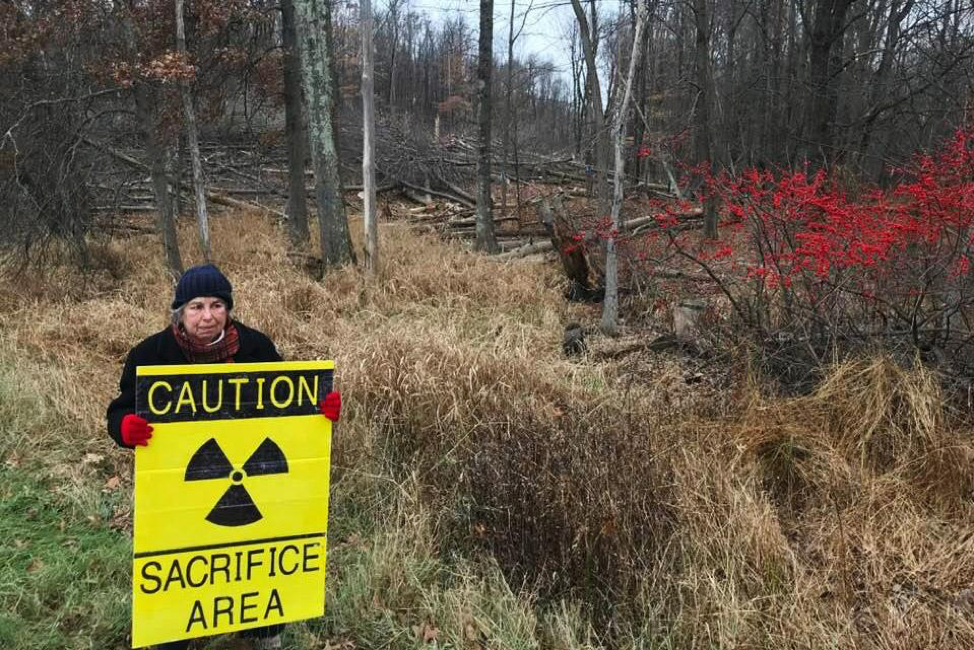
Civil Disobedience – Strategic Legal Action
Last summer, six individuals from Orange County, New York were sentenced to seven days in jail for their civil disobedience – blocking the CPV construction site for 26 minutes. While on the superficially the action might seem like a minor delay, it was a strategic action of non-violent civil disobedience. As the six defendants were asked to give testimony for why they had blocked access to the plant, this opportunity was used to enact a legal record of the known health and climate impacts on future generations that would result by the operation of the CPV power plant. The court testimony from Dr. Robert Howarth on climate impacts, Dr. Larysa Dyrska on health impacts and Dr. Anthony Ingraffea on water impacts are now public record both in courts documents and Protect Orange County Website. This was also leveraged with traditional media outlets, particularly for the participation of actor and activist James Cromwell.
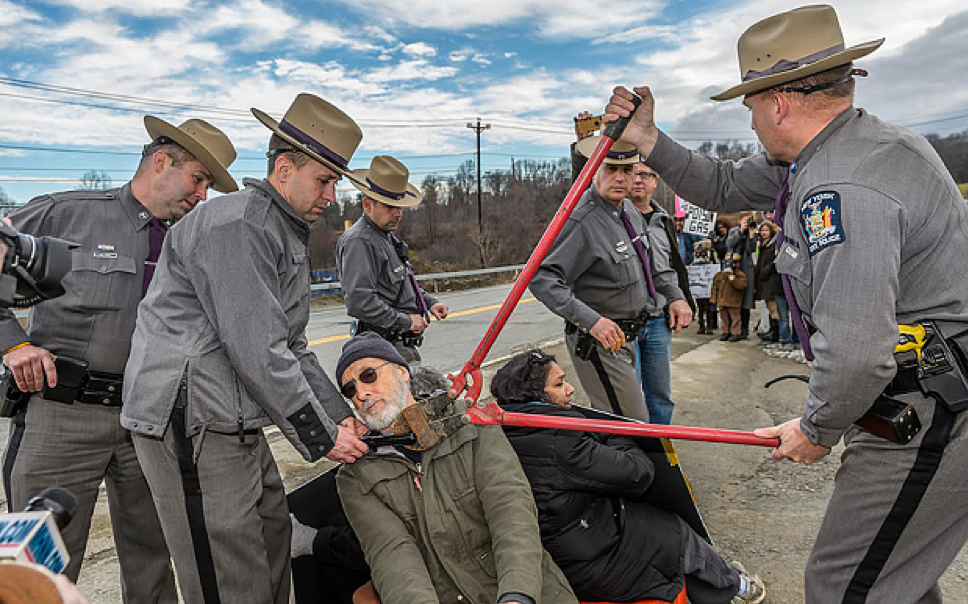
Barely a year later, on April 23rd, 2018 communities from all over New York State will converge upon the state capital, Albany, peacefully demanding that Governor Cuomo “Walk The Talk” and halt all gas infrastructure. There are several planned occupations and civil disobedience actions planned for this day, which may well turn the tide, particularly as Cuomo faces increasing political pressure to enact the “green agenda” he promised in 2015.
Fifty years after Martin Luther King’s assassination, we are now in a new era of revitalized civic engagement and protest. His words, written from the Birmingham jail in 1963 speak to the cause of justice, even while knowingly breaking the law: “I submit that an individual who breaks a law that conscience tells him is unjust, and who willingly accepts the penalty of imprisonment in order to arouse the conscience of the community over its injustice, is in reality expressing the highest respect for law.”
References
[1] U.S. dry natural gas production averaged 73.6 billion cubic feet per day (Bcf/d) in 2017. EIA forecasts dry natural gas production will average 81.1 Bcf/d in 2018, establishing a new record. EIA expects natural gas production will rise by 1.7 Bcf/d in 2019.
[2] 42 USC §13201 et seq. (2005)
